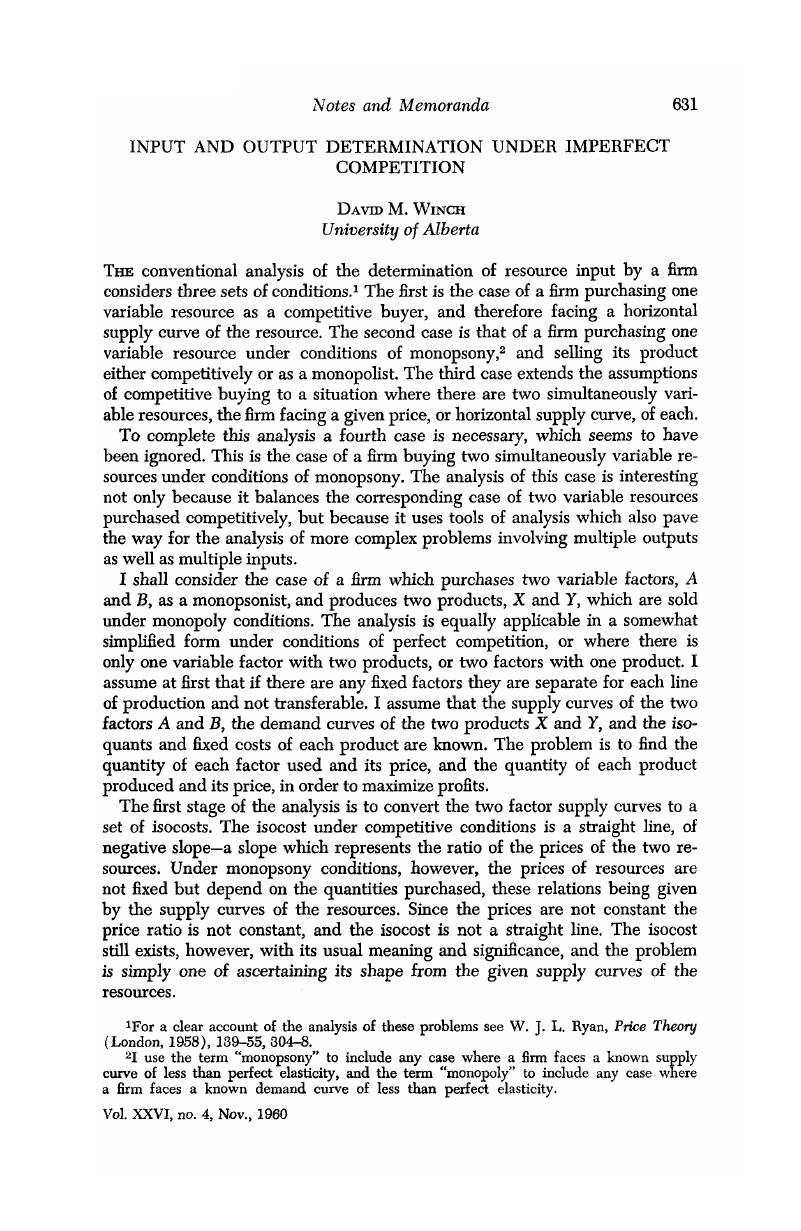Article contents
Input and Output Determination under Imperfect Competition
Published online by Cambridge University Press: 07 November 2014
Abstract

- Type
- Notes and Memoranda
- Information
- Canadian Journal of Economics and Political Science/Revue canadienne de economiques et science politique , Volume 26 , Issue 4 , November 1960 , pp. 631 - 638
- Copyright
- Copyright © Canadian Political Science Association 1960
References
1 For a clear account of the analysis of these problems see Ryan, W. J. L., Price Theory (London, 1958), 139–55, 304–8.Google Scholar
2 I use the term “monopsony” to include any case where a firm faces a known supply curve of less than perfect elasticity, and the term “monopoly” to include any case where a firm faces a known demand curve of less than perfect elasticity.
3 This article does not attempt to deal with the problems of analysis where the isocosts, isoquants, isorevenues, and isofactors do not have the normal curvature. These cases are interesting and important, of course, but become so complicated as to exclude them from a simple exposition of the basic technique of analysis.
4 This analysis assumes that the demand curves for the two products are independent, that is, that the demand curve for X is not affected by the price of Y, or the quantity of Y sold, and vice versa. In the case of two commodities which are substitutes or complements from the standpoint of the consumers, the demand curves will be interdependent. The price of X will then be dependent on both the quantity of X and the quantity of Y sold, and the demand surface for X can be constructed with the quantity of X measured on the horizontal axis, the quantity of Y on the vertical axis, and the price on the perpendicular axis. From this a total revenue surface for X can be constructed with the same vertical and horizontal axes, but with the total revenue on the perpendicular axis. A similar total revenue surface for Y can be constructed on the same axes, and by adding these two surfaces perpendicularly a total revenue surface is obtained. Cross-sections of this surface at various heights on the perpendicular axis will be the isorevenues. A similar technique can be used to construct the isocosts where the supply curves of the resources are interdependent, replacing the technique of Figure 1 where independent supply curves were assumed.
5 The transformation function shows the possibilities of transforming a given output of X into alternative combinations of X and Y by different use of the factors. The isofactor shows the alternative combinations of X and Y which can be produced by a given factor input. Given two or more variable factors there might be numerous transformation functions for any given output of X depending on the factor combination used to produce that given output. Similarly, numerous isofactors might pass through any given point in Figure 2. These two sets of curves would of course be the same. The importance of the distinction in terminology is in the given datum assumed by each. Given any number of variable factors there is only one isofactor possible for each assumed factor input, but given more than one variable factor there are numerous transformation functions possible for each assumed product output. When concerned with more than one variable factor I shall therefore use isofactors to avoid ambiguity.
6 The term “joint” is used to imply a simultaneous use of fixed factors in the production of both commodities, as in the case of complementary products, where the ratio between the outputs of X and Y is variable. The term “transferable” implies that the fixed factors may be devoted in various proportions to the production of X and Y, but where a single unit of the fixed factor cannot De used simultaneously for both outputs, as in the case of alternative products.
- 1
- Cited by




